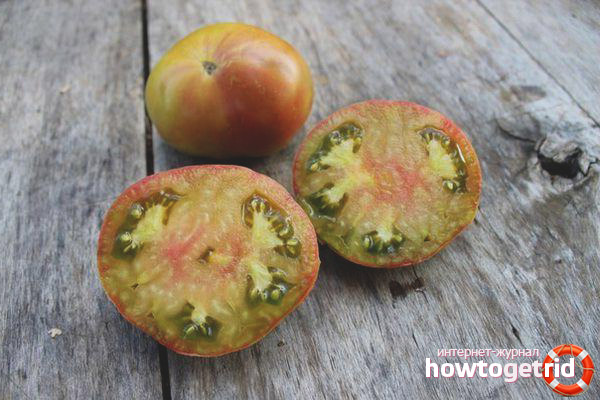The content of the article
The variety belongs to the indeterminate variety of mid-season tomatoes. With proper care, the plant reaches a height of 1.2-1.6 meters. Since the variety is tall, it requires mandatory garters to the support or trellis, the formation of a bush. Under heavy branches with fruits put additional props in order to prevent breakage of the brushes. To get the maximum yield, the variety Black Pineapple is formed in two shoots.
Description
The bushes are quite powerful, with abundant leaf cover and a well-developed root system. Fruits are rounded, slightly flattened. With proper care grow up to half a kilogram. Original chocolate-colored hearths, fleshy and juicy. Tomatoes have high palatability. The peel is quite dense, with a mature tomato acquires a dark brown hue.
- Thanks to the strong skin, tomatoes are successfully preserved and do not crack during heat treatments. This variety is quite popular, it is resistant to transportation over long distances, has a long shelf life after removal from the bush.
- In the chambers of the fetus there is a small amount of seeds. In the context of each ripe berry, you can see your individual pattern.
- If you don’t know about the special color of this crop, you might think that the crop began to rot. As a rule, the taste in varieties with brown fruit is an order of magnitude higher than in red or yellow tomatoes.
- The disadvantage of this variety is the impossibility of whole preservation due to the size of the fruit. Also, the variety is consumed fresh, it can easily decorate any holiday table.
- With proper care and a favorable climate from one bush on average you can get up to four kilograms of product.
If this crop is grown for the purpose of implementation, and you plan to transport it, then you need to harvest until the fruits are in a state of technical maturity.
Cultivation and care
The best predecessors for this variety will be: carrots, herbs, peas, onions.
This culture has a significant number of advantages, namely:
- High yields.
- Great taste.
- Original coloring of tomatoes.
- Long shelf life.
- Resistance to transportation.
Despite all the advantages, this variety has certain disadvantages:
- It is imperative to garter plants to the support.
- Shrub formation is also needed.
- Not suitable for whole fetal preservation.
- The variety is demanding on constant and regular top dressing.
- It is necessary to carry out the herding procedure.
Soil preparation
When growing, an important point is the preparation of the soil. A lot depends on this procedure. The highlight is the acidity of the soil. For the most part, all varieties of this culture prefer light soil, and Black Pineapple was no exception.
In the event that the soil acidity is excessively high, it will have to be liming for about three years. Only after this time you can plant tomatoes.
When planting in open ground, take into account the fact that the variety should never be planted immediately after eggplant, potato or bell pepper.
It is advisable to add humus or peat to the soil. In order to avoid further disease of tomatoes, before applying fertilizers for a certain time, it is frozen. For the successful development of tomatoes, they need to be fed with the following drugs:
- Peat.
- Sawdust.
- A small amount of ash.
- Humus.
- Organic fertilizers.
Watering
One of the key points is watering, since the size of the fruits and their quantity depend on it. This crop does not tolerate drought. If you go too far with watering, the risk of fungal diseases and rotting of the plant increases.
Mulching
When covering the soil with straw, it is necessary to additionally add nitrogen to compensate for its loss due to the consumption of microbes for the decomposition of fiber.
If straw, grass or leaves serve as mulch, with the onset of rainy days or before watering, additional 300-400 g per 10 square meters of nitrogen fertilizers (ammonium nitrate, urea, ammonium sulfate) must be added. If this is not done, the bacteria destroying the fiber of straw will take away the nitrogen of the soil and cause plants to starve for this element, which can inhibit the growth of the bush and, accordingly, reduce the yield.
Harvesting can be carried out for 110 days from the moment of transplanting seedlings in open ground.
Video: tomato black pineapple











Submit